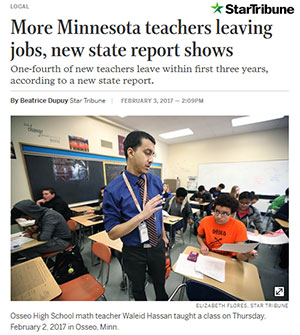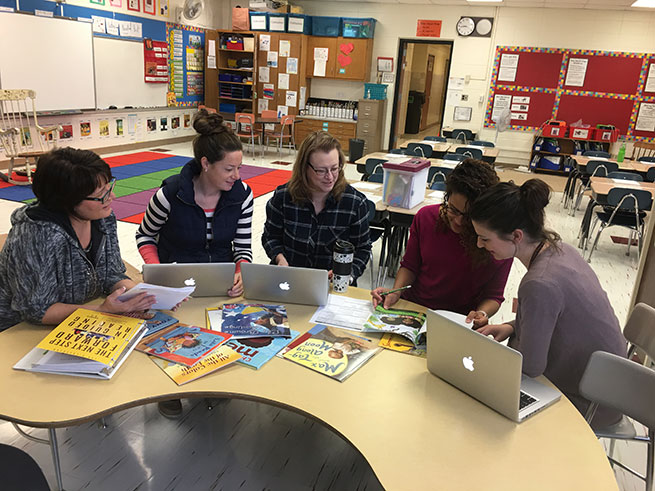Recent headlines are sounding the alarm:
 More Minnesota teachers leaving jobs, new state report shows
More Minnesota teachers leaving jobs, new state report shows
One-fourth of new teachers leave within first three years, according to a new state report.
The statewide teacher shortage described as an “epidemic” has Minnesota school districts searching for strategies that will increase teacher retention. A February, 2017, Star Tribune article offers a startling statistic that should be stopping school boards, administrators, legislators and most importantly parents in their tracks:
“The 2017 version of the Minnesota Teacher Supply and Demand report issued Wednesday found a 46 percent increase in the number of teachers leaving the profession since 2008.”
While I believe a number of other issues also deserve our attention (increasing the number of teachers of color, improving teacher training, and closing the achievement gap), we cannot ignore the fact that the future of education is uncertain at best. Some might even say the future is bleak.
However, as a self-professed champion of positivity and on behalf of the hundreds of colleagues I have worked with over the past 26 years, I have compiled a short list of requests. Investing in these five straightforward conditions would send a strong message that we are serious about addressing the need to attract and retain high-quality teachers for our children.
Isn’t it time to listen to the teachers when we ask for the following?
#1. High quality training in classroom management and engagement
Ask any first year educator what he/she learned about these essential components of teaching in their undergraduate courses and the answer will likely be “Little, if anything.” The sad truth is that our colleges and universities are not doing an exceptional job of preparing new teachers for the challenges they will face when it comes to creating classroom environments that are conducive to learning. We must do better. Before the degrees are granted, as well as once new teachers are standing in front a classroom full of kids, learning how to establish a climate where kids can and want to learn is essential.
#2. Reasonable class sizes
And speaking of that classroom full of kids… Despite the studies that insist class size doesn’t really matter all that much, 99.9% of teachers will tell you, CLASS SIZE MATTERS! A lot! Last year I taught two sections of Language Arts. My first section had 31 students, my second section just 22 students. The amount of time I could devote to small group reading with students in the second section was obviously much greater than with students in the first section. Excellent teachers strive to create meaningful relationships with students, they believe in providing relevant feedback, and they understand the importance of connecting with parents. Accomplishing these goals is possible with 22 students. Making it happen consistently with 31 students is a feat that most teachers find overwhelming.
#3. Ample classroom library and supply budgets
There is a joke often shared on social media that teaching is the only profession where you steal from home and take things to work. Surveys have shown that the average teacher spends at least $500 out of their pocket for everything from Kleenex to snow boots to graham crackers. We not only worry about keeping students healthy, warm, and fed, but we also invest heavily in putting books on our shelves year after year. Many teachers I know dream of winning the lottery in order to stock his/her classroom with the basic essentials. Rather than make us wait for our lucky numbers to hit, how about if the school boards, administrators, and school finance gurus help us meet the needs of students today! We’re not asking for millions, but $500-$1,000 per year would help a great deal.
#4. Time in our classrooms during “back to school workshop” days
Every August it’s the same old story. Teachers sit through hour after hour, day after day of meetings and workshops that are supposed to help us become the best teachers we can be. The intentions are honorable. Most of us realize this. But here’s the thing, our minds are elsewhere during this crucial time period. It is tough to get or stay engaged in talk about interventions, effective math routines or even worse, new rules for using the laminator, when more than two dozen little people and their families will be walking through the door for open house in 48 – 72 hours. Give us the time we need to get our classrooms ready. Make it a priority to limit those August workshop sessions in favor of supporting us in a substantial way – with adequate time to be in our classrooms preparing for our learners and the adventures that lie ahead.

#5. Ongoing, job-embedded, teacher-driven professional development
The benefits of “one and you’re done” or “sit and git” workshop training days are minimal. Oftentimes there is little change in beliefs or behaviors after attending this type of PD. As an instructional coach, I am privileged to be in a district that values investing in teacher development and growth. I have worked in several other districts that have not approached professional development in the same way. Honoring teacher voices in this process is the way to foster systemic change and sustain improvements. Recently I joined a group of teachers as they collaborated on creating a teacher-friendly guided reading lesson plan format. It was so impressive to see how they bounced ideas off of one another, discussed their rationale and insights, or offered differing opinions on how to approach the plan. There was a lovely mix of synergy, respect, and affirmation. They knew what they were doing and they were doing it well. The next day, they decided to put in a request for half-day subs so everyone on the team could dig even deeper into their understanding and implementation of the new approach to guided reading. This is the type of professional development we need. No one at the district office or State Department of Education could do a better job of prescribing or designing effective training.
Ask the teachers. And most importantly, listen to them. They know. Trust me. They know. Trust them. They really know.

Great article, Maurna! ❤
Thank you, Jane!
Awesome article. We need to support our teachers.
Thanks so much , Kay! Supporting teachers is the key to supporting our kids and their learning!
Thank you for this article, Maurna. All of your requests for teachers are exactly right! Even though it’s been years since I’ve been in the K‑12 classroom or library, I had the same desires. May I add another request? That request is for full-time school librarians to collaborate with teachers. Teachers and librarians working together can truly make a difference for both the students and the teacher. It provides support that can increase student achievement. Hooray for teachers and school librarians and all the folks that work with and for children!
Thank you for your kind words, Heidi and yes, you are absolutely right! Full time school librarians who collaborate with teachers to promote a school-wide love of literacy are essential!
You are so, so right, Maurna! As a former classroom teacher myself, and someone who still visits dozens of schools every year, all of your suggestions are on the mark. Yes, please listen to the teachers!
Thanks, David! In addition to school librarians, I should also have included making it a priority to bring authors into schools! Creating a school culture that puts a love of literacy and learning ahead of test scores is critical!